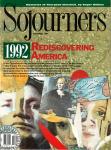In the beginning was Columbus. Everything else in the Americas is prehistorical, pre-Columbian. So goes the creation story of the Americas from the perspective of the European conquerors.
Every great social project needs a creation myth. The myth of origin that undergirds the United States, pointed out sociologist Robert Bellah during the country's bicentennial, is loosely based on the biblical stories of the journey of a "chosen people."
Anchoring the myth are the fabled "crossing voyages" that brought the European to the Americas, from Columbus to the Mayflower to Ellis Island. (Other voyages, such as slave ships or Drake's pirating, are just as fundamental to the story, but are of course suppressed in the idealized myth of "discovery.") According to this archetypical story, unknown seas were sailed by determined heroes, often fleeing persecution, who endured great danger and hardship to arrive in the Promised Land.
Tragically, however, when coupled with ideologies of cultural superiority and economic exploitation these origin myths provided the justification for an unparalleled apocalypse (from the perspective of the indigenous people of the Americas) of European conquest and occupation. This legacy should be doubly distressing for Christians: The biblical stories were misappropriated in the service of domination, and the historical project of genocide was carried out in our name.
In fact, the true biblical tradition always challenges the myths of origin that legitimate oppressive social systems. We can see this, for example, in the Genesis parody of the Babylonian Enuma elish creation myth (Genesis 1-2), the New Testament parody of the imperial liturgy of military triumph that sanctified the creation/maintenance of the Pax Romana (Mark 11:1-10; Colossians 2:14f), and the apocalyptic subversion of the idealized Golden Age of the past with the New Jerusalem to come (Revelation 18, 20).
The 1992 quincentennial gives us a unique opportunity to provide a biblical critique of European-American myths of origin. While there are many places to look in carrying out this crucial task, the gospel is a good place to begin, since it represents the true "re-creation story" for the Christian movement.
IN THE BEGINNING, always and everywhere, is the good news of renewal for a people in need of vision, according to Mark's gospel (Mark 1:1). The world and salvation history are thus "regenerated" in Mark's story. A new Exodus (1:2f) is prepared by a new Elijah (John the Baptist, 1:6), and taken up by a new "sibling" empowered by the Spirit and a new baptismal covenant (1:8-11).
This new Human One (see 2:10) endures the archetypical wilderness journey/testing (1:12f), and then announces that the new human social order is imminent: The kairos has arrived (1:14f). So begins the discipleship journey, a struggle for that new order through a mission of proclaiming repentance, healing, and exorcism. The people of God are symbolically regathered in a new community of 12, reappropriating the vision of Israel's liberated tribal confederacy (see 3:13-19).
It is in the second phase of this gospel journey, however, that we come upon stories that offer a radical alternative to the discovery myth of the Europeans' America. The so-called "miracle cycle" of Mark (4:35-8:21) also begins with a boat-crossing story, but one that has very different consequences than that of Columbus and his legacy.
"When evening had come, Jesus said to his disciples, 'Let us go across to the other side'" (Mark 4:35). The following boat voyage across the sea of Galilee, in which the disciples are almost lost in a fierce storm (4:37), represents the central organizing metaphor of Mark's miracle cycle narrative. Its themes are repeated with heightened drama in 6:47ff, where the disciples again encounter Jesus as they struggle in vain to row against the wind. They are for a second time indicted by him for their lack of understanding, a crisis that becomes the focus of Mark's third and final boat-crossing story (8:13ff).
Mark refers to the freshwater lake that lay at the heart of Galilean life as a "sea" to invoke primal imagery from the First Testament. Passage through the watery chaos is fundamental to the creation/liberation story of the Hebrew people. We need recall only three deliverances: Noah from the flood (Genesis 7-8; see Psalm 104:25f), Moses from Pharaoh's army (Exodus 14; see Psalm 48:4-8), and the prophet Jonah from the "belly of the beast" (Jonah 1-2). Israel's is a God who "makes a way through the sea" (Isaiah 43:16), and Yahweh's protection of the people in the midst of storms on the deep is celebrated throughout the Psalms (see 46:1-3; 55:8; 65:7; 77:16-20; 107:23-29).
But if Mark's sea voyages are archetypical, where are they going? The destination is noted simply as "the other side," the shore east of the Jordan River, which emerges in Mark as the symbolic locale of the stranger, the Gentile, the social "other." These then are not voyages of escape, discovery, or conquest; rather, they are forays beyond the accepted social boundaries of first-century Palestinian Judaism in order to extend the messianic mission of liberation to the alienated and the outcast.
This vision of reconciliation and justice is narratively articulated by the cycle of parallel actions on the "Jewish" and "non-Jewish" sides of the sea: exorcisms (1:21-28; 5:1-20), healings (5:21-43; 7:24-27), and wilderness feedings (6:32-44; 8:1-20). No wonder then that the disciples' sea-crossing adventure is almost scuttled by the wind and waves! The storms represent the "cosmic" opposition by all the forces of established order to this experiment in a new social order.
What a contrast between the Columbus and gospel voyaging myths! The mercenary adventurer sailed in order to subjugate, possess, and exploit, armed not only with swords but the more dangerous ideology of entitlement and ethnocentric superiority. Jesus' mission was diametrically opposite: He crossed to liberate those "possessed" by their subjugators (see the story of "Legion," Mark 5:1-20), to enfranchise those excluded by ideologies of entitlement and ethnic superiority (see the story of the Syro-Phoenician woman, 7:24-30), and to empower those exploited (see the story of economic satisfaction through organized sharing, 8:1-9).
IT IS WORTH MENTIONING another archetypical journey that takes place in the middle of this Markan narrative cycle: Jesus' dispatching of his community on mission (6:7-13). Having been called (1:16ff) and commissioned (3:13ff), the disciples are given explicit instructions as to how to carry out their vocation of proclaiming repentance, exorcism, and healing. Three things characterize Jesus' model of evangelism -- regrettably none of which guided the European "mission" in the Americas.
First and most important, disciples are to travel in a manner that makes them utterly dependent upon the hospitality of those to whom they are going (6:8f). They are strictly exhorted to take along an absolute minimum of their own cultural "baggage"; the distressing history of missionary work as an arm (wittingly or no) of cultural imperialism explains the wisdom behind this travel advisory. Such "missionary vulnerability" to the receiving people would seem to preclude the possibility of evangelism-as-domination, since it properly conceives of crosscultural interaction in terms of host and guest.
Second, when the disciples arrive at a place (in small groups, not armed settlement colonies), if received they are to settle peaceably among the inhabitants (6:10). Proclaiming the gospel and healing carries no imperative whatsoever to impose the missionary's own way of life.
Finally, if the missionaries are not welcomed, the instruction is simply to move on, with only a gesture of regret. The host culture, in other words, is to be left alone (6:11). Needless to say, this is a far cry from forcibly converting the people indigenous to the place, much less dispossessing them of their land and way of life!
One can only wonder how the history of the Americas might have been different if Christian missionaries would have abided by their Lord's specific instructions. Instead, a strange dialectic of illusion characterized the ideology of the European newcomers. The New World was on the one hand a paradise peopled with innocents to be converted and riches to be taken, and on the other a wilderness to be tamed and subjugated. Contaminated by racism, materialism, and greed, the "errand in the wilderness" eventually became secularized into Manifest Destiny, an imperial theology of entitlement that continues to wreak devastation around the world, most recently and brutally as "Desert Storm."
THIS BITTER LEGACY invites careful reflection upon that poignant gospel archetype of disciples who must "strain at the oars against the storm" (6:48). Primal forces, now rendered more powerful than ever by technologies of destruction, continue to oppose the messianic journey of solidarity with the outcast. It is surely instructive that one of the most primitive symbols of the early church was that of a boat at sea, an ecclesial image that survives today in the logo of the World Council of Churches. The modern ecumenical movement rightly understands that "we are all in the same boat" when it comes to our struggle to carry on the messianic "crossing" against the storms.
The 1992 quincentennial will represent an important moment in the "war of myths." From a biblical perspective, the Pinta, Nina, and Santa Maria must be relegated to their place among the "ships of Tarshish," those imperial fleets of trade and exploitation disdained by the Hebrew prophets (see Isaiah 23; Ezekiel 27). If we Christians are to participate in a more human and equitable re-creation of the Americas for the next five centuries, we had better return to our own "origin myth." It provides a badly needed and compelling alternative to the "sea and land" journeys of conquest, from Cabrillo and Cortez to Bush and Schwarzkopf.
Moreover, we would do well to listen to another voice, long silenced: the quite different set of creation myths of the indigenous peoples of the Americas. As a displaced and displacing culture, we have a lot to learn from stories of place.
Facing these issues is particularly incumbent upon those of us who are in one way or another immigrants to the Americas. Our families, too, made that primal crossing, by sea or land. We must choose which boat story we wish to identify with, and this choice will profoundly influence our stance in the struggle for a just and genuinely multicultural future for the continent.
Challenging the creation stories of the present social order will be difficult ("Why dredge up the ghost of Columbus?" people will say). It will be all the more discomforting for those of us who are by class, race, or gender "entitlement" inheritors of the imperial project -- its myths and its legacy. But the Lord of the Sea insists we make the risky crossing (6:45). And it is in the midst of the storm that we encounter the "I AM," who assures us that the journey is not in vain: "Take heart, do not be afraid" (6:50).
Ched Myers was author of Binding the Strong Man: A Political Reading of Mark's Story of Jesus (Orbis Books, 1988) when this article appeared. This scripture reflection is drawn from The American Journey, 1492-1992: A Call to Conversion, an eight-session study guide, by Stuart Taylor, Cindy Moe-Lobeda, Ched Myers, and Marie Dennis, published by Pax Christi USA (348 East Tenth St., Erie, PA 16503; 814-453-4955).

Got something to say about what you're reading? We value your feedback!
